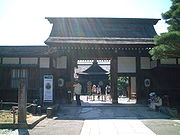
Takayama Jinya
Encyclopedia

Hida Province
is an old province located in the area of Gifu Prefecture. It was sometimes called . The province was in the Tōsandō area of central Honshu.-History:...
under the direct control of the Edo Bakufu (Shogunate). It was established in what is currently Hachiken-machi, Takayama City, Gifu Prefecture
Gifu Prefecture
is a prefecture located in the Chūbu region of central Japan. Its capital is the city of Gifu.Located in the center of Japan, it has long played an important part as the crossroads of Japan, connecting the east to the west through such routes as the Nakasendō...
.
History
The building originally belonged to Lord Kanamori, ruler of the Hida Takayama HanHan
-China:* China , an abbreviation or adjectival modifier for things Chinese* Han Chinese , the dominant majority ethnic group of China and overseas Chinese...
, who used it as his villa. However, after the Bakufu Government sought to bring Hida under its direct control in 1629, it was rebuilt by Ina Tadaatsu and served as offices for the local deputy administrator. After 1777, it became the local government office.
After the Meiji Reformation, the building was used as Takayama prefectural offices. In 1929, it was designated as an historical landmark, but continued being used as public or prefectural offices by a number of public entities until 1969. As the only remaining building of its kind, Takayama Jinya is now under protective ordinances as an historical asset and has been restored almost entirely to its original Edo Period
Edo period
The , or , is a division of Japanese history which was ruled by the shoguns of the Tokugawa family, running from 1603 to 1868. The political entity of this period was the Tokugawa shogunate....
state.
Summary

The grounds and building are open to the public for a fee, and there is information about the history of the building during the Edo Period displayed inside.
There is a farmer's market (jpn. asaichi 朝市) held every morning in front of Takayama Jinya, along with a farmer's market held on the banks of the Miya River.
Miscellaneous
The Ippon-sugi Hakusan Shrine, which is located in the same area of town, celebrates the Jinya InariInari
Inari may refer to:* Inari , a Shinto spirit** Mount Inari in Japan, site of Fushimi Inari-taisha, the main Shinto shrine to Inari** Inari Shrine, shrines to the Shinto god Inari* Inari Sami, one of the Sami languages...
. Because this shrine does not house any festival floats, it does not participate in the bi-annual Takayama Festival
Takayama Festival
The in Takayama in Japan started in the 16th to 17th century. “The origins of the festivals are unknown”; however they are believed to have been started during the rule of the Kanamori family. Correspondence dated 1692 place the origin to 40 years prior to that date...
parade. Visitors can see other festivities (e.g. traditional lion dances) hosted by this shrine at Takayama Jinya during the spring Takayama Festival.

